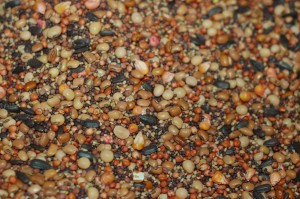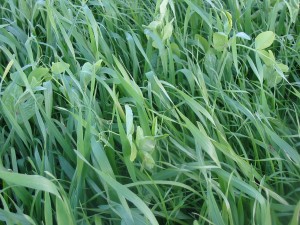
Diversity is always a goal with cover crop mixes. More species feed a greater number of microbes and beneficial insects, and different types of crops can produce a synergistic effect and complementary growth habits. There are limits to what you can do successfully, however – starting with seed size.
A mix with species of similar seed sizes has the highest likelihood of success, since they need similar planting depths and conditions for the best emergence. For example, it’s more difficult to establish small seeds without tillage and a prepared seed bed, because they don’t have the energy stores of larger seeds to germinate, establish roots, and emerge in a seedbed environment cluttered with residue. Large seeds are better equipped to work around minor residue when it makes seed-to-soil contact less than perfect.
More uniform seed size often translates into more uniform emergence vigor, which means similar growth rates – assuming you are comparing annuals to annuals or perennials to perennials. Species that grow at faster rates can be more competitive with slower, lower growing species (depending on their proportion in the mix and how shade-tolerant the late bloomers are).
We’ve seen this in simple mixes like triticale with a clover, where the small-seeded clover gets drowned out by the large-seeded, rapidly growing triticale. The same phenomenon can often be seen with mixes of a large number of species where there is no way to optimize seeding practices for all the mix contents, and often only a handful of the most competitive species will be the ones expressed.
If you are trying to put together a mix with very different seed sizes, it would be ideal to use both the large and small seed boxes on the drill, separating the smaller seeds – clovers, brassicas, millets – into the smaller box, and the larger seeds, such as small grains and peas into the larger box. If everything is combined in one box, smaller seeds tend to settle out. Separating by seed size ensures that everything gets planted at the appropriate depth, but it also creates the less practical step of having to separate the mix into separate bags or batches.
Diverse mixes can be broadcast, but uniform seed size still holds its advantage here. It helps get the seed distributed evenly, since the larger seeds will get thrown farther. Success also depends on how heavily the broadcasted seed is covered over with disking. Be careful with disking; deeper disking is likely to bury the seeds deeper.
Dramatically different seed sizes in a mix can also cause the smaller seeds to settle out and miss even distribution in the field this way, even when the mix is drilled.
If you are creating a mix with legumes, larger seeded legumes grow quicker and do better in winter annual mixes – especially with tall, competitive species like small grains and ryegrass. These legumes include winter peas and hairy vetch.

If you want a clover as part of the mix, it can be better to combine it with species that will act as a nurse/companion crop at first and then winterkill, alleviating competition for winter and spring. This includes oats or spring barley. If you do want spring production from the small grain, go with triticale, rye, or winter barley at about 50 lbs/acre.
None of this means that a mix of varied seed sizes won’t work; it will just require a little extra care in planting management. For the commercial mixes that we sell, we try to set a seeding depth that is a good compromise between the typical depths used by the various species. Pay attention to depth settings, pay attention to whether you are getting good seed to soil contact, and make sure that the seedbed is well prepared. This becomes more delicate the more species you have in the mix. If it’s a custom mix, it’s also very important to balance the species based on seed size and competitiveness. Err on the side of giving the small seeds – especially the slower-growing perennials – the advantage when calculating these proportions, something a King’s AgriSeeds agronomist can help you with.
Speak to an expert at King’s AgriSeeds now at 1-717-687-6224 or email us at [email protected].

2 Comments. Leave new
I am getting ready to plant 26 acres of Double Play. I saw on the tech sheet that manure needs to be applied prior to seeding. I will not be able to get the manure until 3-4 weeks
after planting. Will that prevent or hinder the germination of the Double Play?
Thank You !
Jim
Jim,
We generally don’t recommend fertilizing in the fall after the crop is up. This leads to too much growth before the winter, and can cause problems with winter hardiness and survival. We see this especially with ryegrass and mixes that contain ryegrass, including Double Play. And at only 3-4 weeks growth, spreading may do some damage to the crop. Your best bet is to wait until the spring and spread manure at green-up.
Genevieve